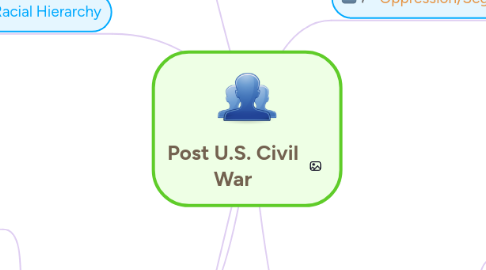
1. Laws/policies
1.1. Policies reconfigured the category of whiteness to include European immigrants.
1.2. GI Bill of Rights was arguably the most massive affirmative action program in American history.
1.2.1. Helped male, Euro-origin GIs.
1.2.2. Not extended to African Americans
1.3. "From 1917 to 1924 a series of legislative acts reduced immigration to the United States by 85%"
1.3.1. Reducing the entry of those who were considered inferior races/breeds.
1.4. The result of these policies was that African Americans were totally shut out of the Suburban boom.
2. Labor/work
2.1. In America as a result of the Napoleonic wars, domestic manufacture had grown and were in need of wage laborers. They scooped up the displaced Irish to make them into an unskilled labor force.
2.2. " Jews built a small-business-based middle class in the interwar years."
2.2.1. occupational barriers fell and new fields opened up to jews
2.3. Americans felt less politically threatened by Mexicans since they were considered a transitory labor force.
2.3.1. labored in dead-end jobs
2.3.2. "Mexican's shifting position in a changing economic and labor system as they competed with poor whites and blacks jockeying for a better position in the evolving social order
2.4. "Historically, racial difference has been one key division among the ranks of the working class
3. Racial Hierarchy
3.1. "Thus as a portion of the Irish dispora became known as "the Irish," a racial (but not ethnic) line invented in Ireland was recreated as an ethnic (but not racial) line in America."
3.2. The Irish in America choose not to go the "whole hog" , but opted to the privileges and burdens of whiteness.
3.2.1. While the white skin made the Irish eligible for membership in the white race, they had to earn it since their admission was not guaranteed.
3.3. "American anti-Semitism was part of a broader pattern of late nineteenth-century racism against all southern and eastern European immigrants as well as against Asian immigrants, not to mention African Americans, Native Americans, and Mexicans."
3.3.1. These views justified all sorts of discriminatory treatments.
3.4. Compared with other immigrants, Jews were upwardly mobile.
3.5. The post war period was a historic moment for real class mobility.
3.6. "Mexicans were legally classified as white, and thus they could become U.S. citizens. Yet they were often not accepted as socially or culturally white
4. Education
4.1. Jews in great numbers were the first Euro-immigrant group to enter college.
4.1.1. Faced discrimination there and had remained largely excluded.
4.1.2. Jewish families placed a high value on hard work and education
4.2. Block of both admission of black students and promotion of Jewish Instructors.
4.3. "Neither religion nor ethnicity separated us at school or in the neighborhood. Except temporarily."
4.3.1. Jews, Catholics, Protestants, Italians, Irish, Poles,"English", were mixed up on the block and in school
4.4. Mexicans attended segregated schools.
4.5. Black colleges were overcrowded
4.5.1. The few African Americans who did gain access to their educational benefits were able to become doctors, engineers, and enter the Black middle class.
5. Oppression/Segregation
5.1. The penal laws regulated every aspect of Irish life, as a result Ireland was established as a country where Irish Catholics formed an oppressed race.
5.2. In 1882-1927, closed the doors to immigration from Europe and Asia
5.3. During world war I, racism shaped the army's development of a mass intelligence test.
5.3.1. Intellectual status of immigrants had been disquietingly low
5.4. Deemed ineligible for naturalization.
5.4.1. Including Chinese, Japanese, and other Asians.
5.5. "Stereotypes and misconceptions about race, skin color, religion, class, and sexuality can determine who is interrogated at the border and who is let in with an approving nod."
6. Land/housing
6.1. In the mid-eighteenth century Catholics only held 7% of Irish land.
6.2. Irish, Italian, and Jewish ex-urbanites gave it a more suburban and democratic taste.
6.3. Mexicans lived in marginalized neighborhoods
6.4. Home developers refused to sell to African Americans with the help of the government.
6.4.1. It was in a housing policy that the government's racism reached its highest point.
6.4.2. there had been white riots in Pennsylvania development when black families moved in.
